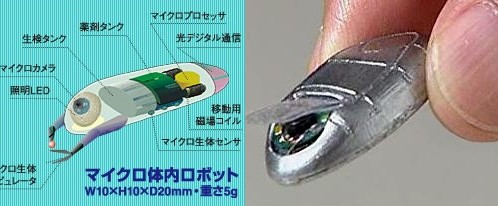
The robots, developed by The Ritsumeikan University and announced on the 26th February 2007, are about 20mm long by 10mm wide.
The researchers have created a number of different prototypes based on the technology with specialised sensors and manipulators. These include a drug delivery system, a set of tiny manipulators (forceps) and a camera for imaging as well as other sensors and manipulators. The robots are encased in bio-compatible plastics, and uses a magnetic system for positioning and movement in the body.
Looking somewhat like a high-tech scarab, the system allows minute surgery to be conducted without massively invasive procedures. It is definitely a step in the right direction. One potential drawback is that it is still connected to the controlling computer via a cable. The cable may double up as a tether to retrieve an errant robot. This possibly makes it slightly less manoeuvrable than a completely wireless model, but the possibility of loosing one in a body and then requiring further invasive surgery is not a very welcome one.
Examples of application are to send a robot on a mission to seek and destroy cancerous tissue in an area, by imaging and identifying then delivering a localised dose of a drug designed to destroy it. The potential is endless. As small robots like these, and smaller